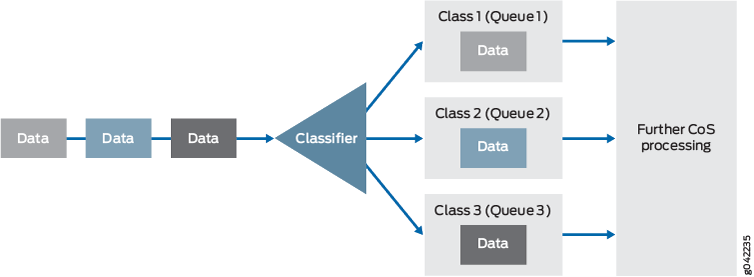Overview of Assigning Service Levels to Packets Based on Multiple Packet Header Fields
Behavior aggregate (BA) classification (see Understanding How Behavior Aggregate Classifiers Prioritize Trusted Traffic), where packets are classified based on their QoS markings, is the most common way to assign service levels because it is straightforward and based on a well-established, fixed-length header fields, which makes them computationally more efficient. However, sometimes BA classification does not provide sufficient granularity, or the QoS markings in the packet headers cannot be trusted. In such situations, multifield classifiers can be used. A multifield classifier is a method of classifying traffic flows based on multiple packet header fields. Devices that sit at the edge of a network usually classify packets based on multiple packet header fields. Multifield classification is normally performed at the network edge because of the general lack of DiffServ code point (DSCP) or IP precedence support in end-user applications.
In an edge router, a multifield classifier provides the filtering functionality that scans through a variety of packet header fields to determine the forwarding class for a packet. Typically, a classifier performs matching operations on the selected fields against a configured value. A multifield classifier can examine multiple fields in the packet header: destination address, source address, IP protocol, source port, destination port, and DSCP value. Multifield classifiers are used when a simple BA classifier is insufficient to classify a packet.
Figure 1 provides a high-level illustration of how a classifier works.

In Junos OS, you configure a multifield classifier with a firewall filter and its associated match conditions. This enables you to use any filter match criteria to locate packets that require classification. From a CoS perspective, multifield classifiers (or firewall filter rules) provide the following services:
Classify packets to a forwarding class and loss priority. The forwarding class determines the output queue. The loss priority is used by schedulers in conjunction with the random early discard (RED) algorithm to control packet discard during periods of congestion.
Police traffic to a specific bandwidth and burst size. Packets exceeding the policer limits can be discarded, or can be assigned to a different forwarding class, to a different loss priority, or to both.
You police traffic on input to conform to established CoS parameters, setting loss handling and forwarding class assignments as needed. You shape traffic on output to make sure that router resources, especially bandwidth, are distributed fairly. However, input policing and output shaping are two different CoS processes, each with their own configuration statements.
